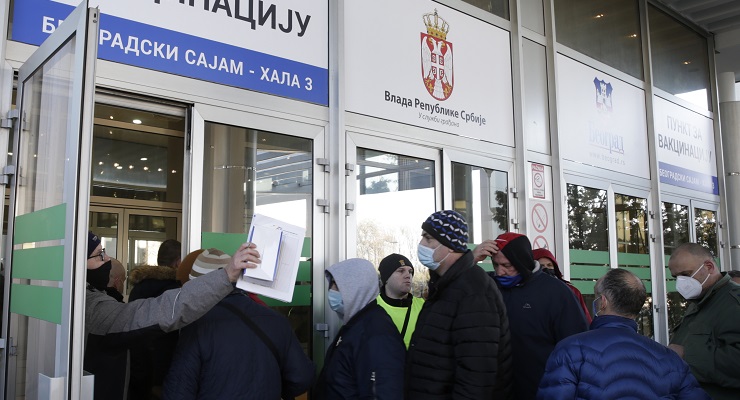
This is part one in a series.
The ship has sailed on vaccine equity. Rich countries have preordered enough COVID-19 vaccines to inoculate their populations multiple times. The World Health Organisation’s vision of equal access through COVAX is at risk of failing and mass immunisation in low-income countries isn’t likely until 2024 — if at all.
Vaccine nationalism — where countries put their populations first, time and time again — is being met with vaccine diplomacy, with China stepping up as a seemingly charitable friend.
Experts say these new allegiances represent a big shift in global power relations.
Narrow self-interest and unfilled promises
COVAX aimed to deliver 2 billion vaccine doses by the end of 2021 to cover 20% of the most vulnerable people in 91 low- and middle-income countries, with a focus on frontline healthcare workers and the vulnerable. But it has secured only 1.07 billion doses so far as richer national snatch up supplies.
Now, 90% of people in 67 low-income countries stand little chance of being vaccinated in 2021.
Wealthy countries with only 14% of the world’s population have bought 53% of the eight top vaccine candidates. The UK has bought enough to give every person more than five doses.
Although the UK has vaccinated more than 11% of its population, EU countries including Italy, Poland, Finland and Germany have vaccinated only between 2% and 3%. And doses have already been delayed. AstraZeneca manufactured less of its vaccine than expected and Pfizer paused manufacturing to upgrade a plant in Belgium. Some regions have seen a 60% fall in the number of doses delivered.
University of Sydney specialist in global health security Associate Professor Adam Kamradt-Scott tells Crikey equity is off the table.
“This is precisely what COVAX was designed to circumvent,” he said. “Countries have been competing with one another for vaccine deals to ensure they weren’t let behind and the effect of this was irreversible.
“The ship for vaccine equity has sailed … Unless we see cooperation we’re looking at a pandemic that will last until 2026.”
While some countries have pledged to donate a percentage of their secured doses and manufacturers have said they will provide some vaccines to lower-income nations which don’t have deals, it’s too little too late.
“The point of the COVAX facilities is to ensure our countries have access to the vaccine at an appropriate time, as they come off the line,” WHO group lead on supply and access to medicines Lisa Hedman said in an online round table discussion last week which Crikey attended.
“Not as a donation after someone has identified that they have extra, not as a donation at the end when the prices have gone down, and not at the end when it’s no longer relevant or where it’s too late to be effective in a public health context.”
A threat to global world order
After doses didn’t arrive from the EU, Serbia became the first European country to use China’s Sinopharm vaccine. President Aleksandar Vucic said “European solidarity does not exist” and “only China can help Serbia fight the virus”.
Hungary, which complained of slow EU approval of the Oxford-AstraZeneca vaccine, has reached a deal with Russia for the Sputnik V vaccine which doesn’t yet have EU approval.
The EU has sustained a massive reputational hit over its handling of the pandemic — and things aren’t looking good for WHO either, global governance expert Associate Professor Max Kelly tells Crikey.
She says when the pandemic hit, many hoped it would reverse states’ recent march towards sovereignty and the rise in populism — but the opposite happened.
“We’ve been shifting away from multilateralism, but the pandemic is really compounding this issue,” she said.
“It’s entrenching the existing power relations and it’s challenging the global rules-based order, including the WHO.”
What more should Australia do?
Australia has provided $80 million to COVAX to help deliver vaccines around the world. It is also planning to deliver doses of the locally manufactured AstraZeneca vaccine to Pacific neighbours.
It also has partnerships with six Pacific nations to help them develop regulatory approval bodies, similar to the Therapeutic Goods Administration, and allow vaccines and pharmaceuticals approved by the TGA to be approved.
Australia has secured 124.8 million doses. This includes 50 million doses of AstraZeneca’s vaccine which will be manufactured in Melbourne, and 10 million doses of Pfizer’s vaccine announced this morning.
Australia’s secured supplies were “modest”, Kelly says.
“We’re not the frontrunners in terms of vaccine nationalism,” she said. “The government is taking a stronger approach to managing COVID-19 here.”
Passing off extra supplies isn’t easy, either. Australia ended up with a huge surplus of H1N1 vaccines after the swine flu pandemic in 2009 when more than half of the population decided against getting vaccinated because the virus’ threat wasn’t serious enough.
With millions of extra doses, wealthy countries donated vaccines to WHO to distribute — only for them to get bogged down in bureaucracy for months as countries fought over who would be liable for adverse side-effects if it had been improperly stored during transit.








Crikey is committed to hosting lively discussions. Help us keep the conversation useful, interesting and welcoming. We aim to publish comments quickly in the interest of promoting robust conversation, but we’re a small team and we deploy filters to protect against legal risk. Occasionally your comment may be held up while we review, but we’re working as fast as we can to keep the conversation rolling.
The Crikey comment section is members-only content. Please subscribe to leave a comment.
The Crikey comment section is members-only content. Please login to leave a comment.